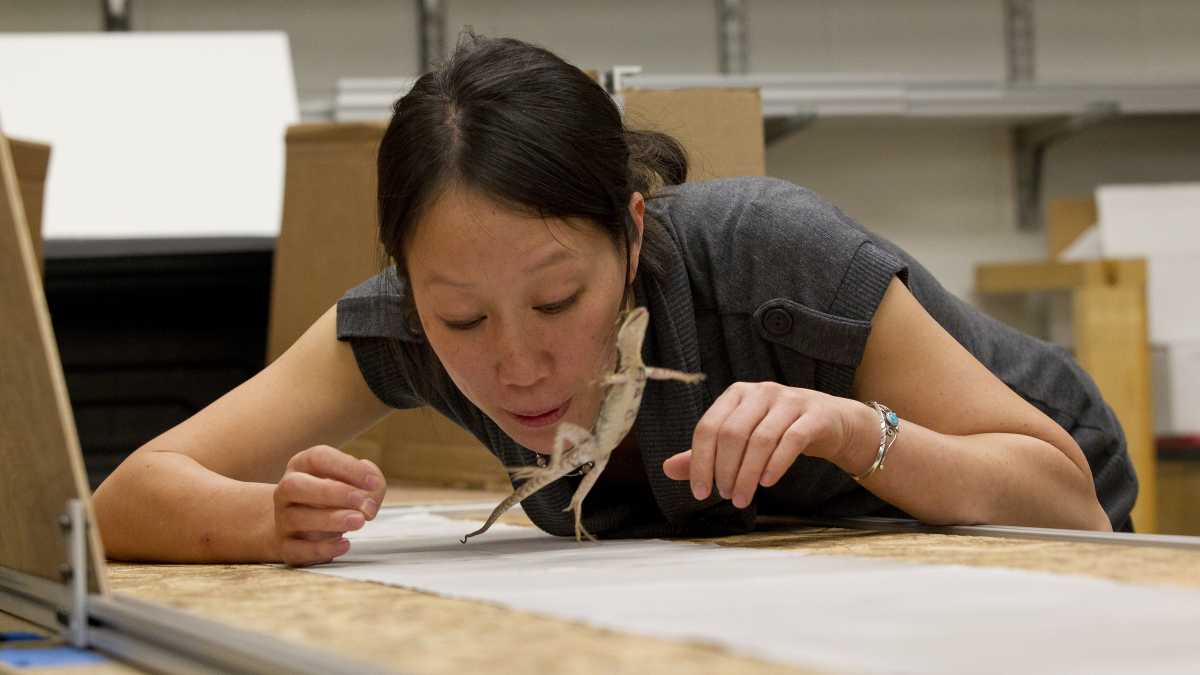One woman, the feet of a gecko and a scientific breakthrough
Listen
Tonia Hsieh at work in her Temple University lab. (Photo courtesy of Temple University)
These days, Tonia Hsieh is in charge of her own lab full of eager science students, but when she was an undergrad, she found herself delving deep into the world of lizard feet.
“Gecko feet are really cool,” says Tonia Hsieh, an assistant professor in the biology department at Temple University in Philadelphia. “If you look at the tips of their toes, they have these toe pads which look like little layers of scales, basically. But when you go and stick that under a microscope, it actually turns out that those little scales are actually made up of thousands of little tiny hairs.”
And if you zoom in even closer, Hsieh says, you’ll see that these little hairs break into what resemble split ends. Exactly how a gecko uses those split ends to stick, though, wasn’t clear to researchers. They knew it wasn’t suction or capillarity or a Velcro-like connection. Instead, the leading gecko theorists of the day suspected something called van der Waals forces, named after a Nobel Prize winning Dutch physicist.
“It is one of those topics that we sort of cover in maybe high school chemistry for about a split second, then move on. And what it really is is, it’s literally the weakest of all the chemical bonds, and it is caused by an overlap of electron clouds between two materials,” she explains.
Gecko observers believed that a gecko exploits van der Waals forces by bringing its foot—and those tiny protruding hairs—so close that the electron clouds overlap with the electron clouds of the surface, be it a wall or tree or whatever it’s intending to climb.
But nobody had ever measured these gecko-produced van der Waals forces before.
So, Hsieh, at the age of 21, gave it a shot.
“Well, I plucked these little tiny hairs that are about 1/10 the diameter of human hair off the toes of these lizards, and stuck them to…a very simple force-measuring device.”
The experiment did not go smoothly.
“Oh no. I spent months and months and hours and hours and hours until like 3:00 or 4:00 in the morning, sitting in this little dark lab by myself, taking these little hairs that I knew were supposed to stick to things and pushing up against this little piece of wire, and it would do absolutely nothing.”
But then she finally figured out the problem: the angle the hair approaches the object from matters.
“We had to push it up against the surface and pull it down, and what that does is, it actually engages it on the surface of this little piece of wire. And once it’s engaged, that thing pulls like mad. It is out of control the amount of adhesion one little piece of hair could produce,” she says.
In fact, later research would find that these hairs could help a gecko hold many, many times its own body weight. These lizards are champs when it comes to hanging tight.
Since Hsieh and her colleagues published their research 16 years ago in the journal Nature, the paper has been cited more than 1,800 times. And other teams have taken up the task, trying to manufacture products based on the toe hair properties.
She thinks it may only be a few years before some sort of “gecko tape” hits the consumer market. And when it does, manufacturers will have Hsieh to thank.
“That’s what a large part of my day typically is—bang-my-head monotonous,” she says, “and then we discover something, and it’s incredibly amazing.”
WHYY is your source for fact-based, in-depth journalism and information. As a nonprofit organization, we rely on financial support from readers like you. Please give today.



